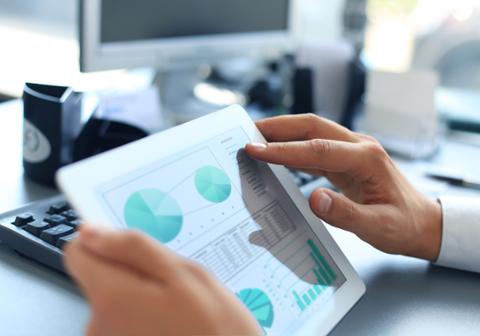 Tablets are outpacing the “traditional” PC market by a wide margin, according to new estimates from IDC. In addition, the research firm believes that smaller tablets—i.e., those with screens less than eight inches in diameter—are becoming more popular than the larger devices that helped establish the segment. According to IDC, tablet shipments will grow 58.7 percent year-over-year in 2013, reaching 229.3 million units—a significant jump from the 144.5 million units shipped in 2012. That’s in stark contrast to the PC market, which is expected to experience its second consecutive year of negative growth. At the current rate, IDC foresees tablet shipments exceeding those of desktops and laptops by 2015. "What started as a sign of tough economic times has quickly shifted to a change in the global computing paradigm with mobile being the primary benefactor," Ryan Reith, program manager for IDC's Mobility Trackers, wrote in a statement. "Tablets surpassing portables in 2013, and total PCs in 2015, marks a significant change in consumer attitudes about compute devices and the applications and ecosystems that power them.” Reith added: “IDC continues to believe that PCs will have an important role in this new era of computing, especially among business users. But for many consumers, a tablet is a simple and elegant solution for core use cases that were previously addressed by the PC." By 2017, IDC predicts that tablets with screens measuring less than eight inches will constitute 57 percent of the worldwide tablet market, followed by tablets in the 8-to-11-inch range with 37 percent, and tablets bigger than 11 inches with 6 percent. That’s in marked contrast to today, when smaller tablets comprise 55 percent of the market, and “regular” tablets 43 percent (tablets bigger than 11 inches own only 2 percent of the current market, according to IDC). If IDC is correct, and there’s an unstoppable trend toward smaller tablets, it could change the game a bit for developers who build data-analytics apps. The Big Data industry is only just beginning to explore the challenges and opportunities that come with building apps for touch-screens; if the market wants those devices to be even tinier, that could drive a lot of future user-interface considerations. How does one display complex visualizations without a whole lot of screen real-estate, for instance? Image: Yuralaits Albert/Shutterstock.com
Tablets are outpacing the “traditional” PC market by a wide margin, according to new estimates from IDC. In addition, the research firm believes that smaller tablets—i.e., those with screens less than eight inches in diameter—are becoming more popular than the larger devices that helped establish the segment. According to IDC, tablet shipments will grow 58.7 percent year-over-year in 2013, reaching 229.3 million units—a significant jump from the 144.5 million units shipped in 2012. That’s in stark contrast to the PC market, which is expected to experience its second consecutive year of negative growth. At the current rate, IDC foresees tablet shipments exceeding those of desktops and laptops by 2015. "What started as a sign of tough economic times has quickly shifted to a change in the global computing paradigm with mobile being the primary benefactor," Ryan Reith, program manager for IDC's Mobility Trackers, wrote in a statement. "Tablets surpassing portables in 2013, and total PCs in 2015, marks a significant change in consumer attitudes about compute devices and the applications and ecosystems that power them.” Reith added: “IDC continues to believe that PCs will have an important role in this new era of computing, especially among business users. But for many consumers, a tablet is a simple and elegant solution for core use cases that were previously addressed by the PC." By 2017, IDC predicts that tablets with screens measuring less than eight inches will constitute 57 percent of the worldwide tablet market, followed by tablets in the 8-to-11-inch range with 37 percent, and tablets bigger than 11 inches with 6 percent. That’s in marked contrast to today, when smaller tablets comprise 55 percent of the market, and “regular” tablets 43 percent (tablets bigger than 11 inches own only 2 percent of the current market, according to IDC). If IDC is correct, and there’s an unstoppable trend toward smaller tablets, it could change the game a bit for developers who build data-analytics apps. The Big Data industry is only just beginning to explore the challenges and opportunities that come with building apps for touch-screens; if the market wants those devices to be even tinier, that could drive a lot of future user-interface considerations. How does one display complex visualizations without a whole lot of screen real-estate, for instance? Image: Yuralaits Albert/Shutterstock.com How Small Tablets Could Complicate Big Data
 Tablets are outpacing the “traditional” PC market by a wide margin, according to new estimates from IDC. In addition, the research firm believes that smaller tablets—i.e., those with screens less than eight inches in diameter—are becoming more popular than the larger devices that helped establish the segment. According to IDC, tablet shipments will grow 58.7 percent year-over-year in 2013, reaching 229.3 million units—a significant jump from the 144.5 million units shipped in 2012. That’s in stark contrast to the PC market, which is expected to experience its second consecutive year of negative growth. At the current rate, IDC foresees tablet shipments exceeding those of desktops and laptops by 2015. "What started as a sign of tough economic times has quickly shifted to a change in the global computing paradigm with mobile being the primary benefactor," Ryan Reith, program manager for IDC's Mobility Trackers, wrote in a statement. "Tablets surpassing portables in 2013, and total PCs in 2015, marks a significant change in consumer attitudes about compute devices and the applications and ecosystems that power them.” Reith added: “IDC continues to believe that PCs will have an important role in this new era of computing, especially among business users. But for many consumers, a tablet is a simple and elegant solution for core use cases that were previously addressed by the PC." By 2017, IDC predicts that tablets with screens measuring less than eight inches will constitute 57 percent of the worldwide tablet market, followed by tablets in the 8-to-11-inch range with 37 percent, and tablets bigger than 11 inches with 6 percent. That’s in marked contrast to today, when smaller tablets comprise 55 percent of the market, and “regular” tablets 43 percent (tablets bigger than 11 inches own only 2 percent of the current market, according to IDC). If IDC is correct, and there’s an unstoppable trend toward smaller tablets, it could change the game a bit for developers who build data-analytics apps. The Big Data industry is only just beginning to explore the challenges and opportunities that come with building apps for touch-screens; if the market wants those devices to be even tinier, that could drive a lot of future user-interface considerations. How does one display complex visualizations without a whole lot of screen real-estate, for instance? Image: Yuralaits Albert/Shutterstock.com
Tablets are outpacing the “traditional” PC market by a wide margin, according to new estimates from IDC. In addition, the research firm believes that smaller tablets—i.e., those with screens less than eight inches in diameter—are becoming more popular than the larger devices that helped establish the segment. According to IDC, tablet shipments will grow 58.7 percent year-over-year in 2013, reaching 229.3 million units—a significant jump from the 144.5 million units shipped in 2012. That’s in stark contrast to the PC market, which is expected to experience its second consecutive year of negative growth. At the current rate, IDC foresees tablet shipments exceeding those of desktops and laptops by 2015. "What started as a sign of tough economic times has quickly shifted to a change in the global computing paradigm with mobile being the primary benefactor," Ryan Reith, program manager for IDC's Mobility Trackers, wrote in a statement. "Tablets surpassing portables in 2013, and total PCs in 2015, marks a significant change in consumer attitudes about compute devices and the applications and ecosystems that power them.” Reith added: “IDC continues to believe that PCs will have an important role in this new era of computing, especially among business users. But for many consumers, a tablet is a simple and elegant solution for core use cases that were previously addressed by the PC." By 2017, IDC predicts that tablets with screens measuring less than eight inches will constitute 57 percent of the worldwide tablet market, followed by tablets in the 8-to-11-inch range with 37 percent, and tablets bigger than 11 inches with 6 percent. That’s in marked contrast to today, when smaller tablets comprise 55 percent of the market, and “regular” tablets 43 percent (tablets bigger than 11 inches own only 2 percent of the current market, according to IDC). If IDC is correct, and there’s an unstoppable trend toward smaller tablets, it could change the game a bit for developers who build data-analytics apps. The Big Data industry is only just beginning to explore the challenges and opportunities that come with building apps for touch-screens; if the market wants those devices to be even tinier, that could drive a lot of future user-interface considerations. How does one display complex visualizations without a whole lot of screen real-estate, for instance? Image: Yuralaits Albert/Shutterstock.com 
